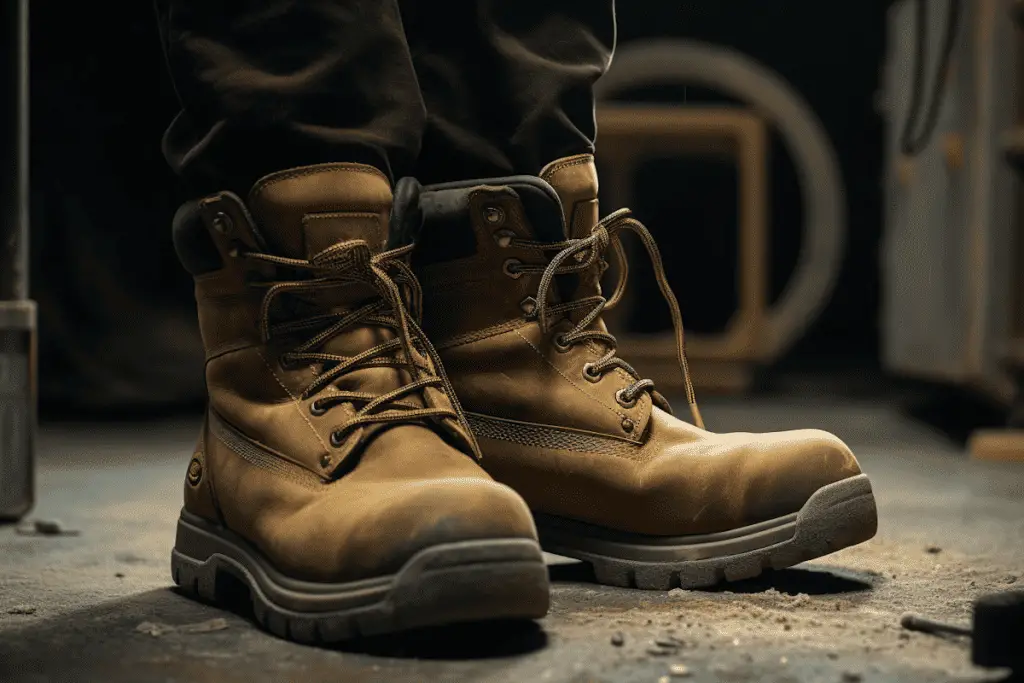Steel toe boots offer up a fantastic amount of protection. Wear them and you most certainly won’t have to worry about stubbing you toe. But, can you hike in steel toe boots?
Yes, you can hike in steel toe boots in warm weather. However, if you hike in steel toe boots in cold weather, you could end up getting frostbite. This isn’t a risk worth taking and it’s why the US Army banned us from wearing jungle boots in the winter.

The Pros and Cons of Hiking in Steel Toe Boots
Alright, let’s talk brass tacks here. Is it a good idea to hit the trails in your steel toe boots? There are arguments to be made on both sides, so let’s lay them all out.
First, the benefits. Steel toe boots are built like a tank. They’ve got that steel cap that protects your toes from any sort of impact or crush injury. If you’re worried about dropping a rock on your foot or kicking a hidden root, steel toes have you covered. Plus, they’re often made with durable materials and waterproof features, which can come in handy if you’re crossing streams or navigating muddy paths.
However, on the flip side, there are some significant drawbacks. For starters, steel toe boots are often heavier than your typical hiking boots. This extra weight can slow you down and make your hike more tiring. They can also be quite rigid, lacking the flexibility that’s so necessary for the varied terrain you encounter when hiking. Moreover, they aren’t designed for prolonged periods of walking, which can lead to discomfort and foot fatigue.
Now the real question is, do the pros outweigh the cons? Or could wearing these boots potentially put you at risk? To answer these questions, we’ll need to take a closer look at the potential hazards of hiking in steel toe boots.
Is It Dangerous to Hike In Steel Toe Boots?
So, we’ve gone over the pros and cons of hiking in steel toe boots. But now, it’s time to talk about something that might raise a few eyebrows. Could you actually lose your toes if you hike in steel toe boots?
Here’s the scoop. There’s a long-standing myth that steel toe boots can cause more harm than good in an accident because the steel can potentially cut into your toes if crushed with immense force. However, studies and real-life experiences have largely debunked this myth. Still, that doesn’t mean hiking in steel toe boots is risk-free.
The main risks of hiking in steel toe boots come from how they fit and perform, not from the steel itself. The rigid structure and heavier weight can lead to discomfort and foot fatigue, increasing the chances of slips, trips, and falls. Plus, if the boots don’t fit properly, you could be facing issues like blisters, corns, or even toenail loss. And trust me, no one wants to deal with that halfway up a mountain.
On top of all of that, you also have to worry about getting frostbite.
A Cold Reality: The Risk of Frostbite
Here’s a chilling fact that you may not have considered: steel toe boots can increase your risk of frostbite in cold conditions. Yep, you heard right. Frostbite. It’s not just for Arctic explorers anymore.
You see, steel is an excellent conductor of temperature. In simple terms, that means it quickly takes on the temperature of its surroundings. So if you’re out hiking in cold weather, the steel in your boots can become as cold as the snowy trail you’re on. Your toes, being in direct contact with that cold steel, are at risk of becoming dangerously cold.
Frostbite occurs when your skin and underlying tissues freeze, and it’s a serious condition that can lead to permanent damage and even amputation. In freezing conditions, your body prioritizes keeping your core warm, meaning less blood flows to your extremities, like your toes. This, coupled with the conductive properties of steel, could put your toes at an increased risk of frostbite.
Now, does this mean you’ll definitely get frostbite if you hike in steel toe boots in cold weather? No, not necessarily. But it’s a risk factor you should be aware of. If you’re planning to hike in cold conditions, it’s worth considering footwear specifically designed for cold-weather hiking. These boots offer better insulation, keeping your toes toasty warm and well-protected from the cold.
Other Protective Footwear Options for Hiking
Alright, we’ve established that steel toe boots, while super sturdy, might not be the best fit for a hike. So, what’s a safety-conscious hiker to do? Well, the good news is there are plenty of other protective footwear options that can offer both comfort and safety on the trails.
First up, let’s talk about composite-toe boots. These boots, like their steel cousins, have a protective cap in the toe area. But instead of steel, they use materials like plastic, carbon fiber, or Kevlar. These materials still provide solid protection but have a couple of advantages over steel. They’re lighter, so they won’t weigh you down as much on the trail. Plus, they don’t conduct temperature in the same way, so you won’t have to worry about frostbite risk in colder weather.
Next up, we have hiking boots with toe bumpers. These boots may not have the same level of protection as a steel or composite toe, but they offer a bit of extra security without compromising on weight or flexibility. The toe bumper is a piece of extra tough material, usually rubber, that’s added to the front of the boot to provide some protection against stubs and stumbles.
But remember, when it comes to hiking, protection isn’t just about the toes. Good ankle support, a sturdy sole for grip, and waterproofing are all important factors to consider when choosing your footwear. So, while steel toe boots might seem like a safe choice, don’t be afraid to explore other options that could provide a safer and more comfortable hike.
Hiking Boots vs Steel Toe Boots
Let’s face it, when it comes to hiking, the boots you wear can make or break your experience. You need comfort, you need safety, and it’s crucial to find a balance between the two. So, how do hiking boots stack up against steel toe boots?
First off, hiking boots. These babies are designed specifically for, you guessed it, hiking. That means they’re built to handle uneven terrain, provide ample support to your ankles, and ensure excellent grip on both wet and dry surfaces. They’re generally more flexible than steel toe boots, and they’re often lighter, reducing foot fatigue during those long treks. Plus, many hiking boots are designed with additional insulation for cold weather, or breathability for hot weather, making them suitable for a variety of hiking conditions.
Now, on to steel toe boots. We’ve covered this territory before, but it’s worth repeating. Steel toe boots offer excellent toe protection – arguably the best you can get. They’re also typically very durable and can handle some harsh conditions. However, they’re not made for the long, often strenuous walks that come with hiking. They’re heavier, less flexible, and may not offer the right kind of support or grip needed for a hike.
In essence, while steel toe boots may offer top-notch protection, they may compromise on comfort and suitability for the hiking trail. On the other hand, hiking boots are designed specifically for the trail, balancing comfort and safety, to ensure your hike is as enjoyable and risk-free as possible. The bottom line? Consider your needs, the conditions you’ll be hiking in, and choose your footwear wisely.
Tips for Hiking in Steel Toe Boots
In case it isn’t obvious yet, I don’t think it’s a good idea to hike in steel toe boots. Hiking boots are my number one choice for hiking and if I can’t hike in hiking boots, I’ll choose a hiking boot alternative over a steel toe boot. This being said, I want to make sure you’re safe regardless of what you hike in, so here are some tips for hiking in steel toe boots.
Firstly, fit is key. Make sure your steel toe boots are the right size. This might seem obvious, but remember, the fit might change when you’re hiking for long periods compared to short walks around a worksite. Try the boots on with the same socks you plan to wear while hiking. And remember, there should be enough room to wiggle your toes comfortably, but not so much that your foot slips inside the boot.

Secondly, give yourself time to break them in. Steel toe boots are notoriously stiff and can take some time to soften up. Wear them around the house, for short walks in your neighborhood, and gradually increase the wear time before you embark on your hike.
Next, don’t forget about the cold. If you’re hiking in cold weather, remember the risk of frostbite we discussed earlier. Consider using thermal socks, and take regular breaks to warm up your toes if necessary.
Lastly, listen to your feet. If you start feeling discomfort, fatigue, or pain, don’t push through it. This could lead to serious injuries. Rest, adjust your footwear if needed, and if the discomfort continues, call it a day. There’s always another day to conquer the trail!
